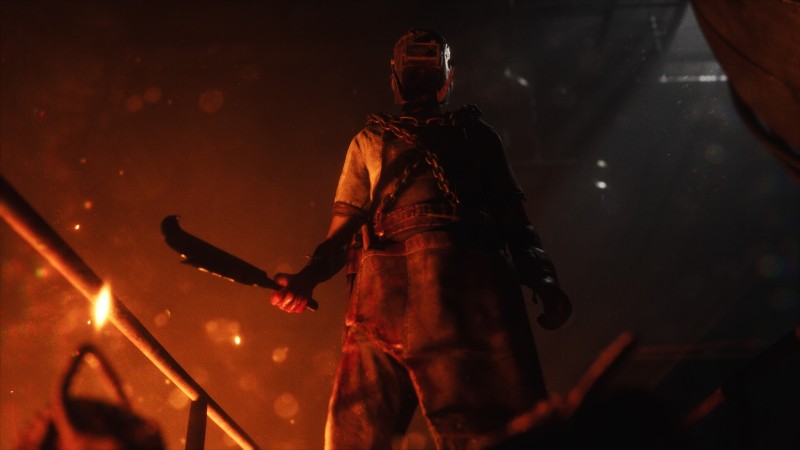Adept and Humane are looking for buyers….
Dead By Daylight Spin-Off The Casting Of Frank Stone Gets Chilling Gameplay Trailer

The Casting of Frank Stone, the upcoming narrative horror game set in the Dead By Daylight universe by Until Dawn developer Supermassive Games, has its first gameplay trailer. The game was first announced at the 2023 Game Awards.
The story unfolds in 1980 in the town of Cedar Hills, a town scarred by the murderous killer Frank Stone. It stars four friends who set out to create a horror film at a derelict steel mill dubbed Murder Mill. Naturally, that goes as horribly as you’d imagine, and players must survive by making choices that decide the characters’ relationships and fates. Sudden quick-time events can also be the deciding factor between whether someone lives or dies.
[embedded content]
Similar to Supermassive’s previous titles like The Quarry and the Dark Pictures Anthology, The Casting of Frank Stone can go down multiple paths based on your choices. Players will also solve environmental puzzles and gather clues to learn more about Cedar Hills
The Casting of Frank Stone still has no release date, but it will launch later this year for PlayStation 5, Xbox Series X/S, and PC.
Could “Robot-Phobia” Worsen the Hospitality Industry’s Labor Shortage?
The hospitality industry has grappled with a severe labor shortage since the COVID-19 pandemic. As businesses struggle to find enough workers to meet the growing demand, many have turned to robotic technology as a potential solution. However, a recent study conducted by Washington State University suggests…
Mortal Kombat 2 Movie Gets October 2025 Release Date

Warner Bros. has announced when Mortal Kombat 2, the sequel to 2021’s Mortal Kombat film adaptation, will arrive in theaters and IMAX, and it’s coming next year. More specifically, Mortal Komat 2 will hit the silver screen on October 24, 2025, meaning we still have about one and a half years to go until we see what’s next for these characters.
The first Mortal Kombat movie in this rebooted film series hit theaters on April 23, 2021, and Game Informer had a great time with it – read our 8 out of 10 review to find out why here. Here’s hoping we enjoy the sequel just as much, if not more.
Mortal Kombat director Simon McQuoid will return to direct Mortal Kombat 2, and it will be written by a new writer, Jeremy Slater (alongside McQuoid), who wrote Disney’s Moon Knight series. Alongside returning cast and characters, The Boys Karl Urban will join the fight as Johnny Cage.
For more Mortal Kombat, read Game Informer’s Mortal Kombat 1 review, and then check out John Cena’s Peacemaker debut in the game here.
Are you excited for Mortal Kombat 2? Let us know in the comments below!
Hi-Fi Rush Gets Final Patch To Fix Minor Issues, Reconfirms Limited Physical Edition

Hi-Fi Rush is getting one final patch today to address some minor issues in the game. Plus, the Hi-Fi Rush X (formerly Twitter) account has reconfirmed a physical edition of the game is coming from Limited Run Games.
This update from the Hi-Fi Rush X account comes roughly one week after Xbox shut down the game’s developer, Tango Gameworks, alongside Redfall studio Arkane Austin, and two more Bethesda teams. While there won’t be any more Hi-Fi Rush content coming from Tango Gameworks, hopefully today’s patch puts the game in the best playable state possible so that future players can enjoy the 2023 hit.
Thank you all for your continued support.
We’re working to release the physical edition of Hi-Fi RUSH with our partners at Limited Run Games, as well as a final patch to address some minor issues releasing later today.
❤️
— Hi-Fi RUSH (@hifiRush) May 15, 2024
The closure of Tango Gameworks arrived roughly a year after the team delivered the extremely well-received Hi-Fi Rush, which by Xbox’s own admitted metrics, was a big success. A few days after the closure of these studios, Xbox president Sarah Bond addressed the situation, stating that it’s about keeping the business healthy in the long-term.
For more, read Game Informer’s Hi-Fi Rush review, and then read Game Informer’s profile on the life and career of Hi-Fi Rush creator John Johanas. After that, check out this Game Informer feature about exploring Tokyo’s Shibuya with Tango Gameworks.
Have you played Hi-Fi Rush? Let us know what you think of it in the comments below!
Popular Medieval Strategy City-Builder Manor Lords Surpasses 2 Million Sales In Early Access

Manor Lords, the medieval strategy city-builder and one of 2024’s surprise hits, has surpassed two million copies sold. The game has only been available in PC Early Access since April 26, meaning it achieved this milestone in only three weeks.
Publisher Hooded Horse announced the sales account for Steam, Epic, GOG, and the Microsoft Store (where Manor Lords is also playable through PC Game Pass). The game quickly caught fire, selling 1 million copies a day after launch. Since then, Manor Lords has enjoyed a consistently high concurrent player count, peaking at 173,000 on Steam in its first weekend.
[embedded content]
Manor Lords is being developed by Slavic Games and puts players in the shoes of a medieval lord tasked with building and growing a city. Players manage their city’s community, infrastructure, economy, and defense/expansion, the latter of which unfold as large-scale tactical battles. The intricate social and production systems combined with an ever-changing world (complete with seasonal and weather changes) result in an organic metropolis that players have taken to in a big way.
Manor Lords joins Early Access hits this year, such as Palworld and Hades II. The game’s 1.0 launch is currently up in the air as the game continues to change and improve based on player feedback. It’s off to a great start, though, and we’re curious to see how it evolves throughout its EA period.
EA Sports College Football 25 Arrives In July, Cover Athletes And Editions Revealed

EA Sports College Football finally has a release date, cover stars, and two different editions. The long-awaited return to college football hits PlayStation 5 and Xbox Series X/S on July 19.
Gracing the cover of the game’s Standard edition are Michigan Wolverines running back Donovan Edwards, Texas Longhorns quarterback Quinn Ewers, and Colorado Buffaloes wide receiver/defensive back Travis Hunter. Check out the Standard and Deluxe covers in the gallery below.
The cover reveal comes a day before the game’s full debut tomorrow. So far, we know that College Football 25 features 134 FBS schools, and it’s being developed by Madden developer EA Orlando. The game was first announced in 2021 following a years-long hiatus for college football games due to the 2014 player likeness compensation lawsuit.
Both editions are now available for pre-order. The Standard Edition costs $69.99 and consists of the base game, Alma Mater and Cover Athlete Ultimate Team packs, and Bring Glory Home Ultimate Team Uniform Item.
The $99.99 Deluxe Edition includes three days of early access (July 16-18), 4600 College Football Points, Heisman Hopeful/Alma Mater/Cover Athlete Ultimate Teams packs, and the Bring Glory Home Ultimate Team Uniform Item.
Lastly, a $149.99 MVP Bundle includes the Deluxe editions of EA Sports College Football 25 and the upcoming Madden NFL 25.
How Is Ghost Of Tsushima On Steam Deck? | New Gameplay Today

Ghost of Tsushima, specifically the Director’s Cut, is out on PC today. It’s a fantastic game that should be welcomed with open arms as it makes its way to a new platform, but we were specifically curious about how it performs on Steam Deck. The game is not Steam Deck verified primarily because certain features are not supported on Valve’s handheld, or other comparable mobile PC game platforms. However, the offline content (the single-player campaign and the expansion) has been specifically adjusted to play well on Steam Deck. You can read port studio Nixxes Software explanation here. And spending a little time with the game shows that the single-player campaign does, in fact, play well on Steam Deck. It’s not without its shortcomings – a high-end PC or a PlayStation 5 are still the best ways to play the game – but Steam Deck appears to be a great way to play the game if that’s your only option or you want a portable version.
You can check out some gameplay with commentary from myself and Wesley LeBlanc below.
[embedded content]
Head to Game Informer’s YouTube channel for more previews, reviews, and discussions of new and upcoming games. Watch other episodes of New Gameplay Today right here.
The Best Games You Missed In May (So Far) | GI Show

In this week’s episode of The Game Informer Show, we discuss several of the best indie games you might’ve missed amidst this month’s releases. Specifically, we discuss Animal Well’s mysteries, revisiting Hades I, Lorelai and the Laser Eyes, Paper Trail, With My Past, Indika, and Killer Klowns from Outer Space.
Watch The Video Version:
[embedded content]
Follow us on social media: Alex Van Aken (@itsVanAken), Marcus Stewart (@MarcusStewart7), Wesley LeBlanc (@LeBlancWes), Charlie Wacholz (@chas_mke)
The Game Informer Show is a weekly gaming podcast covering the latest video game news, industry topics, exclusive reveals, and reviews. Join host Alex Van Aken every Thursday to chat about your favorite games – past and present – with Game Informer staff, developers, and special guests from around the industry. Listen on Apple Podcasts, Spotify, or your favorite podcast app.
The Game Informer Show – Podcast Timestamps:
00:00:00 – Intro
00:05:05 – Animal Well
00:18:16 – Hades
00:29:33 – Lorelei and the Laser Eyes
00:38:32 – Paper Trail
00:50:12 – Endless Ocean Luminous
01:01:29 – With My Past Review
01:11:14 – Indika Review
01:24:44 – Killer Klowns from Outer Space
01:31:52 – Housekeeping
Jason Voorhees Gets A Dedicated MultiVersus Trailer

Jason, alongside Agent Smith from The Matrix, had a cameo in the last MultiVersus trailer, but now he is the star. The footage shows off his moveset, like hitting opponents with a machete, collapsing them in a camp bunk bed, and hitting them with a sleeping bag stuffed with the body of another player. You also get a look at at least one of his alternate costumes.
[embedded content]
MultiVersus is a free-to-play game and will launch on May 28 on PlayStation 5, Xbox Series X/S, PlayStation 4, Xbox One, and PC.
For more, read Game Informer’s MultiVersus review after its first launch back in 2022, and then check out Joker’s MultiVersus gameplay and his Batman Who Laughs alternate costume.
Are you jumping back into MultiVersus next week when it launches? Let us know in the comments below!
